13-inch Retina MacBook Pro Review (Late 2012)
by Anand Lal Shimpi on November 13, 2012 2:53 AM ESTThermals & Acoustics
When we looked at the 15-inch rMBP we noted that it was a significant improvement in the thermal department compared to the previous, 2011 MacBook Pro. The move to 22nm Ivy Bridge and 28nm Kepler silicon meant a much better power profile than the outgoing model. Apple also changed the way it brings air through the system. The previous MacBook Pro chassis did all air exchanging through vents near the hinge of the machine. The new Retina systems pull in cool air from the sides and exhaust it at the display hinge.
In the 15-inch rMBP the improved cooling combined with more power efficient silicon helped ensure more consistent performance over time. While the 2011 15-inch MacBook Pro would quickly throttle under heavy CPU and GPU load, the 15-inch Retina MBP didn't have to reduce clock speeds as aggressively to keep the system's thermal footprint in check.
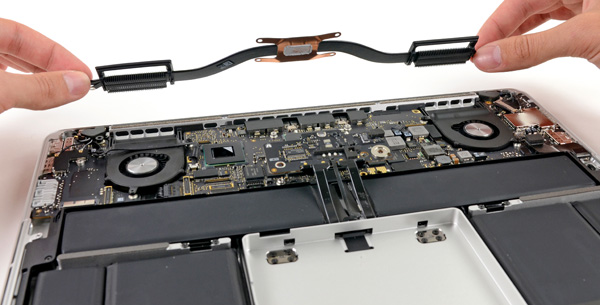
13-inch rMBP cooling solution, courtesy iFixit
With the 13-inch model, the cooling problem is far less of an issue. For starters, Apple only has to remove heat from a single major producer rather than two. There is no discrete GPU in the 13-inch rMBP, so the cooling workload is immediately reduced. Secondly, the 13-inch rMBP is only available with a dual-core 35W Ivy Bridge processor, and not the quad-core 45W parts used in the 15-inch model. With a cooler running CPU and no dGPU, the 13-inch rMBP has a much easier job of staying cool compared to the 15.
To confirm there was no obvious CPU throttling I ran two tests. The first was continuous runs of Cinebench 11.5's multithreaded render benchmark. Prolonged multithreaded FP workloads have always been a great way to drive temperatures up. We didn't see any throttling during this test on the 15-inch rMBP, and it's no surprise that we see no different here with the 13-inch model:
Next up, I ran the same type of test but using Half Life 2 instead. Here I picked settings that provided a good balance of CPU and GPU workload and ran back to back timedemos while monitoring performance:
As expected, there's no obvious drop in performance over time.
Apple also paid attention to acoustics with this generation. Like the 15-inch model, the 13-inch rMBP uses two fans to remove heat from a single heatpipe that runs across the CPU. The fan blades are asymmetrically spaced on each fan to produce a sound that's more varied across the frequency spectrum, rather than concentrated at specific frequencies. The idea is to create the illusion of quiet fans without negatively impacting cooling ability.
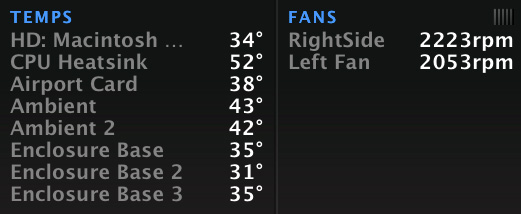
Even more so than in the 15-inch rMBP, Apple's fans in the 13-inch rMBP rarely spin above 2200 RPM. During both the Cinebench and Half Life 2 tests, fan speed remained around 2100 RPM. At these speeds, fan noise is effectively non-existent. In fact, during all of my testing of the 13-inch rMBP there were only a couple of times when I actually heard the fans spin significantly faster than that. Although I would like to see faster silicon and dGPU-level graphics performance in the 13, the obvious benefit of not having four cores and discrete graphics is a very quiet system.
Thermal performance goes hand in hand with acoustics of course. During the Half Life 2 marathon run I kept tabs on CPU and chassis temperature. The results are below:
| Thermal Comparison | ||||
| 13-inch rMBP | 15-inch rMBP | |||
| Max CPU Temp | 52C | 63C | ||
| Max GPU Temp | - | 72C | ||
| Max Surface Temperature (Top) | 48.1C | 49.8C | ||
| Max Surface Temperature (Bottom) | 41.6C | 41.8C | ||
Unfortunately I don't have a 2011 13-inch MacBook Pro to compare to, but the 13-inch rMBP is clearly cooler running than the 15. In terms of user experience, I felt the 13-inch rMBP get warm but never too hot to use on my lap.


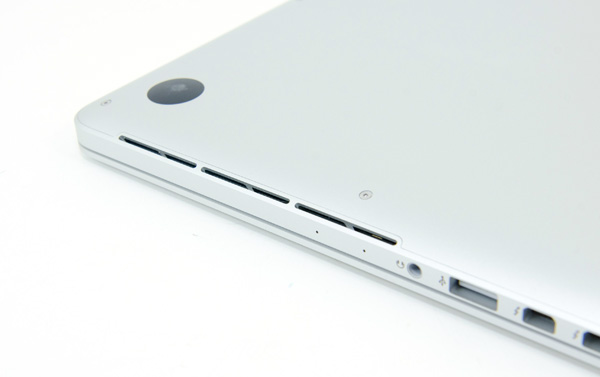
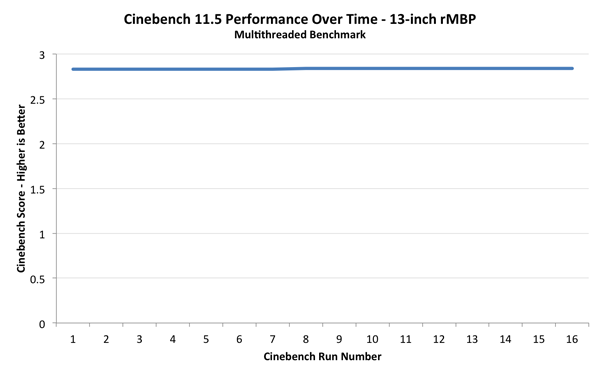
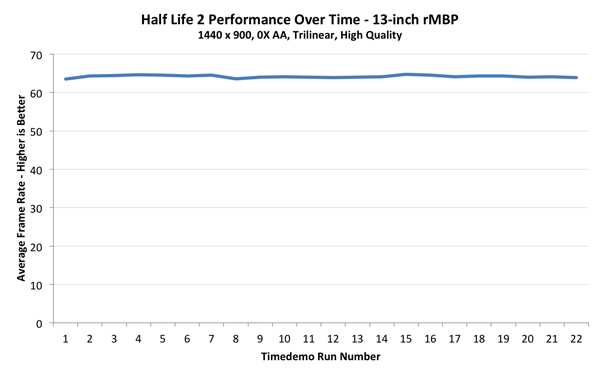








79 Comments
View All Comments
KPOM - Tuesday, November 13, 2012 - link
The 13" MacBook Pro always had a dual core processor and never had discrete graphics. The Retina version is no different in that regard. If it isn't a "Pro" than neither is the non-Retina version.As an 11" MacBook Air user, the weight difference and extra thickness are more noticeable to me. Hopefully Apple comes out with an 11" MacBook Pro with Retina Display, since it does look very nice (I saw one in the store and it blew away the screen on my Air).
Arbee - Tuesday, November 13, 2012 - link
Agreed. Much as the original Air was basically an engineering placeholder waiting for SNB to make it good, this seems to be a placeholder waiting for at least Haswell, and possibly Broadwell.jeffbui - Tuesday, November 13, 2012 - link
Anand, your aspect ratio chart is off. The MBPs are still 16:10jeffbui - Tuesday, November 13, 2012 - link
Oops, looks like you switched the 16:9 chart with the 16:10 chart.iwod - Tuesday, November 13, 2012 - link
I wonder why Apple do not all stick to the same 16:10 ratio. The New iMac is 16:9, while all notebook are 16:10.Aenean144 - Wednesday, November 14, 2012 - link
iMacs have >20 inch screens. When you get that big, there's enough vertical screen space so that wider aspect ratio screens are tolerable.For smaller screen laptops, vertical space is at a premium. 16:10 is at best a compromise to me. Going to 16:9 would make it less usable.
yserr - Tuesday, November 13, 2012 - link
I have a MBP 15" (no Retina). I'm willing to give up GPU or quad, but not both, for portability.Do you think haswell will bring quad core to the 13" MBPr.
I think with the dismiss of the 17" and the trend to smaller, light devices. The 15" will be the new 17" and the 13" will be the new 15".
The 15" rMBP has two soldered ram banks the 13" rMBP has one.
Are there 16GB modules which are reasonable priced for one bank (which apple could offer)?
I will wait for haswell and than decide between 13" and 15".
My dream machine will be 13" rMBP with 16GB Ram and quad.... so I hope haswell will deliver my dream :-)
iwod - Tuesday, November 13, 2012 - link
Quad Core as standard and 2x Graphics Improvement. That is what i am hoping for as well. But with the 4x increase in Pixel count i doubt even Haswell is even good enough in Graphics Department. I just hope Broadwell will bring at least 3x performance over Haswell.yserr - Tuesday, November 13, 2012 - link
At least you see here (http://bit.ly/PalAfy - Haswell Preview) on the haswell slides that they will support 4k and High Resolution Displays. Lets see if they can deliver the performance needed for that. No question Broadwell will be better than Haswell. I hope Haswell will be fast enough for my needs.Kevin G - Tuesday, November 13, 2012 - link
Actually Ivy Bridge does support 4K displays if they are being driving by two DP.Haswell will implement DP 1.2 so it will be able to drive a 4K resolution display over a single cable. The GT3 + eDRAM versions of Haswell should be able to handle accelerated GUI without much issue. Gaming on the other hand at such high resolutions is something even high end GPU's (Radeon 7970, GTX 680) are struggling with.